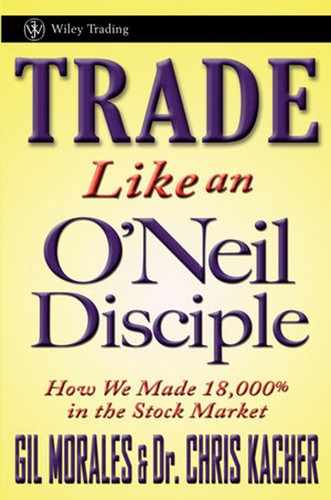1.6. POSITION CONCENTRATION
A big part of handling a winning stock correctly is properly scaling one's position size. If you only want to make average market returns, then scale your positions to a very small size, and your portfolio will act very much like a market index. Having scores of positions is nothing more than "closet indexing." Most mutual fund managers take positions that make up 1 to 2 percent of their portfolio equity or less, and they may have 100 to 200 positions or more. To O'Neil, this is anathema. If you want to make big returns, then you absolutely must concentrate your capital in a strongly-trending stock, and position sizes of 1 to 2 percent of one's total portfolio equity are, to put it bluntly, quite wimpy from an O'Neil perspective. The O'Neil method of pyramiding into strongly acting positions while weeding out weaker ones generally gets an investor concentrated in the right stocks during a bull market cycle. At times, your authors have been fully invested in as few as two stocks, using full, 200 percent margin, so that each position represents 100 percent of the account's gross equity. This is how you make big money in the market, and it is the essence of handling one's stocks properly to achieve maximum effect.
For this reason, O'Neil eschews "diversification" and cites the wisdom of Gerald Loeb, who declared that diversification was a "hedge for ignorance." O'Neil's solution was to be very specific about what stocks one owned in any bull market cycle, suggesting, "The more you diversify, the less you know about any one area. Many investors overdiversify. The best results are achieved through concentration: putting all your eggs in just a few baskets that you know a great deal about and continuing to watch those baskets very carefully" (How to Make Money in Stocks, 4th ed. [New York: McGraw-Hill, 2009], 274).
The purpose of position concentration from an O'Neil perspective is two-fold. On the one hand it allows an investor to fully capitalize on a big price move in a winning stock, while on the other it allows the investor to focus his or her attention on "fewer eggs," which O'Neil views as a safer mental approach than trying to keep track of too many positions at once. Even Livermore himself thought "... that it is dangerous to start spreading out all over the market. By this I mean, do not have an interest in too many stocks at one time. It is much easier to watch a few than many" (How to Trade in Stocks [Greenville: Traders Press, 1991], 33).
To O'Neil, it is not necessary to own every stock in the market; to have a need to "kiss all the babies," as he is fond of saying. He whittles it all down to one basic concept: "The winning investor's objective should be to have one or two big winners rather than dozens of very small profits" (How to Make Money in Stocks, 4th ed. [New York: McGraw-Hill, 2009], 274).
